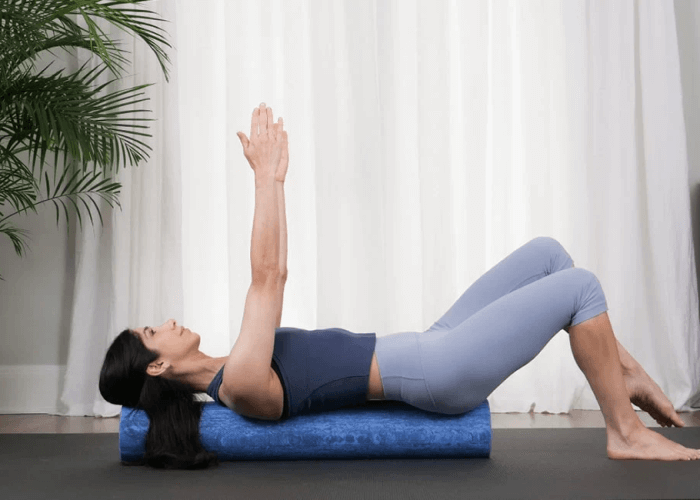Creative Ways to Show Gratitude For How Your Body Moves

When it comes to our bodies, we tend to spend more time criticizing our imperfections rather than appreciating what our bodies do for us each day. I am certainly no stranger to this thought process, which is why I am bringing up the topic of creativity and how it plays into having more gratitude for how our bodies move.
Before becoming a Pilates and Fascia Care instructor, I taught dance for 15 years. My weekly classes included modern dance technique and composition classes. Besides passing down established movement techniques from the greats like Martha Graham, José Limon, Paul Taylor, and others, I also felt a responsibility to create space for dancers to explore their own creativity.
As a dancer who felt deeply fulfilled within improvisation and choreography, I wanted to pass on that skill and joy. I also knew these dancers would be more successful in their careers if they possessed a quickness in mind and movement. They would need to be adaptable to any choreographer’s expression. Even if they didn’t go on to become professional artists, having a strong connection to their individual creativity would benefit them in all aspects of their lives. This meant that I also had to be creative to create new ideas for my long-time students to explore.
One day, I introduced a movement session based around their anatomy. They had lots of fun appreciating lesser considered parts of their bodies for the very first time and it was eye opening for me as well.
Since then, I have used it for inspiration for a deeper gratitude practice and a more connected path to understanding health. Commercial fitness is most often centered around how we look – toning arms, backsides, and six packs — but what if adding a little more creative gratitude into your workouts could give you a deeper connection to your movement routines year-round?
Here are 3 ways you can get creative with your gratitude:
Celebrate an Overlooked Body Part
Working your biceps is great, but have you ever thought about your elbows? Or your ears? It may sound silly, but thinking of your body as a whole when you move makes you appreciate all the wonderful things your body can do.
During an improv class, I instructed dancers to initiate movement from their chosen part and travel through the studio and around their classmates. In yoga, Pilates, weight lifting, or as you’re taking your daily walk, simply become aware of that part and how it’s contributing to your experience.
Appreciate and feel grateful for the role it plays in whatever you’re doing. Your elbows flex and extend, their movement playing a role in propelling you forward or bending to allow you to lower to the floor in a chaturanga or push up. If you are hearing, your ears allow you to hear your teacher’s instructions, your own breath, or perhaps the wind and birds if you are moving outside.
Our minds can become limited, focusing only on parts of our bodies we are dissatisfied with in some way. It can be a part we want to look better or it could be that pain in a particular area has made it difficult to sense much else in our bodies. Both can be vicious cycles that keep us trapped in a negative spiral.
Being a little silly by choosing a body part we ignore or take for granted can open our minds and awareness to the importance of how our body works as a whole. Even when you’re keeping one area stabilized while another moves, ALL of your body’s muscles are involved in that action as well as your entire fascial web.
This switch in your mind’s attention not only opens new neural pathways to your brain, but may be an avenue to a healthier mindset about exercise or a gateway out of pain.
Show your Organs Appreciation
This was a strange but fun class where I introduced thinking about different organs – heart, liver, kidney. It was not your typical place to initiate dance improv from!
Not only was it my students’ first time, but mine as well. It highlighted my own need to know more about these parts inside of all of us – where were they exactly and what do they do? You don’t need to undertake a medical student’s level of education, but a simple Google search will let you know a bit about one of these precious organs and what it needs for good function.
Taking a moment to learn about and feel grateful for these unseen miracle workers teaches us the value of a healthy lifestyle from the inside out.
Say you choose to learn a bit about your kidneys and you discover they are two bean-shaped organs that are about the size of your fists and that they sit on either side of your spine. You learn they filter your blood and that all of your blood passes through them about 40 times per day! You’ll also discover they remove waste and control fluid and electrolyte balance. They also make hormones that help to regulate blood pressure. Now that you are able to feel thankful for some of what they do for you, you can Google how to keep them healthy. You’ll see that movement, a healthy diet, adequate water intake, and not overdoing over-the-counter medications help to keep them in good shape.
As you dance to your favorite tunes, or do your workout, notice that area of your body. Are you moving them around to stimulate and refresh them? Are you drinking enough water? Suddenly, drinking enough water isn’t just about you. Well, it is? But now that you have gratitude for this part of yourself and your loved ones’ kidneys, you might be inspired to take better care of them, rather than seeing those things as a chore.
Step Outside Of Your Own Body
Now that you’ve had practice appreciating overlooked parts of your own body and movement, how about extending that to anyone around you?
Just as our own muscles, organs, and systems operate in relation to one another, so do we affect others and vice versa. The next time you see someone’s mouth move to a smiling shape and their eye muscles respond, allow yourself to appreciate that physical expression and what it brings to the moment. It’s so easy to let that rude driver ruin our commute, but how often do we let the brief moments of positive communication slip away barely noticed?
As a child in the 70’s, my sister and I would play a game while we were riding in our station wagon on road trips. As we rolled along the highway, we would count Volkswagen Beetle cars. How about applying this game to seeing and appreciating positive expressions from others throughout a day? The grown-up version. A simple wave of an arm, someone holding a door.
As you grow your awareness of others’ body language, you’ll probably also see expressions of sadness, frustration, or fatigue. That gives you the opportunity to be a more caring friend, partner, or parent. Feeling gratitude to witness our family and neighbors fosters deeper bonds and empathy. It’s easy to feel grateful for the positive, but opening our hearts to another level of gratitude might deepen our relationships and communication.
Again, these are daily movement expressions we often take for granted, but expanding our creative gratitude to others’ smaller body movements heightens awareness of connection, one of our most basic needs. And maybe it will be like that game my sister and I played, the more you looked, the more you saw.
If saying you’re grateful for your health feels a little stale and disconnected or your workout feels like you’re just going through the paces, try one or all of the above tips for a fresh and inspiring way to expand your awareness.
I used to think that learning anatomy was boring until I accidentally discovered these creative ways to understand it. Now, after many years of small moments of feeling thankful for the small miracles happening constantly in my body and everyone else’s bodies, I am never lacking in things to write about in my gratitude journal. This practice makes me feel more connected to nature and the people I love. It has opened pathways to better health and healing.
Have fun and remember there’s no wrong or right, just exploration!
Sabrina
Let's Stay In Touch!




